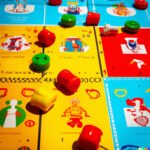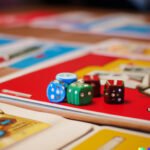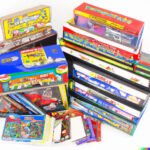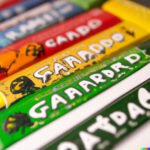Strategy board games have long been a beloved pastime for many, offering a unique combination of mental challenge, social interaction, and immersive gameplay. In today’s digital age, the appeal of these tabletop games has only grown, with enthusiasts seeking out new and innovative titles to add to their collection.
If you’ve ever wondered how to make a good strategy board game, you’re in the right place. Crafting your own game can be a deeply satisfying creative endeavor that allows you to share your vision with players around the world.
When it comes to creating a successful strategy board game, thorough research and planning are essential. By studying existing board games, understanding various game mechanics, and brainstorming unique concepts, you can lay the foundation for a standout game that captures players’ imaginations.
The design process involves crafting an engaging game board that strikes the perfect balance between visual appeal and practicality. Whether you opt for a modular grid layout or a thematic map-style board, careful consideration must be given to how the design enhances gameplay.
Additionally, developing compelling game pieces is crucial in immersing players in the gaming experience. From designing custom tokens and player markers to creating intricate miniatures, each piece contributes to the overall aesthetic and functionality of the game. Clarifying rules and objectives is another key step in ensuring a cohesive gameplay experience. By crafting clear instructions, defining win conditions, and incorporating strategic depth into the game mechanics, you set the stage for an engaging and memorable gaming session.
Research and Planning
Creating a successful strategy board game starts with thorough research and meticulous planning. Before diving into the design process, it is crucial to understand what makes existing board games successful, grasp different game mechanics, and develop a unique concept that sets your game apart from the rest. Here are some key steps to help you navigate through the research and planning phase:
- Study Existing Board Games: Begin by analyzing popular strategy board games to identify common elements, mechanics, and themes that resonate with players. Take note of what aspects make these games engaging and enjoyable.
- Understand Game Mechanics: Delve deeper into the mechanics of board games such as resource management, player interactions, movement systems, and win conditions. Consider how these mechanics can be incorporated into your own game in innovative ways.
- Develop a Unique Concept: Brainstorm ideas for your strategy board game and focus on creating a concept that is fresh, exciting, and offers a unique gameplay experience. Think about what makes your game stand out and how it can captivate players.
By conducting thorough research and planning before diving into the design process, you set a strong foundation for creating a compelling strategy board game that appeals to a wide audience. Understanding existing games, analyzing game mechanics, and developing a unique concept are essential steps in crafting an engaging gaming experience for players.
Remember that the success of a strategy board game hinges on the initial groundwork laid during the research and planning phase. By implementing these strategies effectively, you can ensure that your game not only stands out in a crowded market but also provides an immersive and enjoyable gameplay experience for players. Stay open to new ideas, iterate on your concepts based on feedback from playtesting sessions, and continue refining your game until it reaches its full potential.
Designing the Game Board
To create an effective game board, designers can explore different styles and layouts that align with the theme and mechanics of the game. Whether it’s a modular board that changes dynamically throughout the game or a fixed layout that offers strategic depth, each choice impacts how players interact with the game world. Here are some key considerations when designing a game board:
- Think about the overall visual theme and design elements that will enhance immersion
- Consider the size and shape of the board to accommodate gameplay elements and player interaction
- Balance complexity with simplicity to create a visually appealing yet easy-to-understand layout
Moreover, designers should pay close attention to grid layouts on the game board. Grids help organize gameplay elements, movement mechanics, and spatial relationships between components. The arrangement of grids can influence strategy development, player decision-making, and overall pace of the game. By experimenting with different grid structures like hexagonal, square, or freeform layouts, designers can tailor the gaming experience to suit their vision.
When combining aesthetics with functionality in designing a game board, creators must strike a delicate balance between form and purpose. A visually stunning board may attract players initially, but if it doesn’t support meaningful interactions or strategic depth, it could hinder gameplay enjoyment. Conversely, focusing solely on functionality without considering visual appeal might lead to a lackluster experience. Ultimately, a well-designed game board harmonizes aesthetics with functionality to enrich gameplay and captivate players’ interest in the long run.
Creating Game Pieces
When it comes to designing game pieces for a strategy board game, attention to detail is key. Each component should not only serve a functional purpose but also contribute to the overall theme and immersive experience of the game.
One important aspect to consider is the size and shape of the game pieces – they should be easily distinguishable on the board yet not overcrowd the playing area. Additionally, utilizing high-quality materials for game pieces can enhance the tactile sensation and durability of the game.
Another crucial element in creating game pieces is ensuring consistency in design throughout all components. From custom tokens representing resources or currency to player markers used to indicate movement or progress, each piece should be cohesive with the overall visual aesthetic of the game. This consistency helps in building a recognizable brand identity for your board game and makes it more appealing to players.
Prototyping is an essential step in perfecting game pieces before final production. It allows designers to test different materials, sizes, colors, and shapes to determine what works best for gameplay. Through prototyping, designers can gather feedback from playtesters on the look, feel, and functionality of the game pieces. This iterative process aids in refining not only the physical aspects of the components but also their impact on strategic decision-making within the game.
| Game Design Tips | Importance |
|---|---|
| Attention to detail | Key for immersive experience |
| Consistency in design | Builds brand identity |
| Prototyping process | Aids in refinement through feedback |
Developing Rules and Objectives
Understanding the Basics
When setting out to create a good strategy board game, one of the most crucial aspects to consider is the development of clear and concise rules. Players need to understand how to play the game, what the objectives are, and how they can achieve victory.
This includes outlining win conditions, gameplay mechanics, turn structure, player interactions, and any special abilities or actions within the game. It’s essential to strike a balance between complexity and simplicity in your rules to ensure that players are engaged and challenged without feeling overwhelmed.
Testing for Clarity
Before finalizing your game rules, it’s important to conduct thorough playtesting sessions with a diverse group of players. Not only does this help you refine the gameplay experience, but it also allows you to assess whether your rules are clear and easy to understand.
Pay attention to any confusion or misunderstandings that arise during playtesting and be open to feedback from participants. This iterative process will help you identify areas where rules may need clarification or simplification to enhance the overall player experience.
Embracing Variations
While establishing clear rules is essential for a good strategy board game, don’t be afraid to embrace variations or alternate game modes. Providing players with different ways to experience your game can increase its replay value and appeal to a wider audience.
Consider adding optional rule sets, variants for different player counts, or alternative win conditions that allow for strategic diversity and creative gameplay choices. By incorporating flexibility into your ruleset, you can create a more dynamic gaming experience that keeps players coming back for more.
Playtesting and Iteration
Creating a strategy board game involves more than just developing an intriguing concept and designing eye-catching pieces. It also requires thorough playtesting and iteration to ensure that the gameplay is engaging, balanced, and enjoyable for all players involved. Playtesting is a crucial step in the game development process as it allows designers to gather valuable feedback, identify potential issues, and make necessary adjustments to enhance the overall gaming experience.
One of the key aspects of playtesting is having a diverse group of players participate in testing sessions. By involving players with varying levels of experience, preferences, and playing styles, designers can gain insights into how different individuals engage with the game mechanics, interpret rules, and strategize their moves. This diversity ensures that the game is appealing to a wider audience and provides a more comprehensive assessment of its strengths and weaknesses.
During playtesting sessions, designers should pay close attention to player feedback, observing how participants interact with the game components, react to different scenarios, and engage with one another during gameplay. This feedback can help identify any loopholes in the rules, balancing issues between player strategies, or unclear instructions that may hinder the overall flow of the game.
By listening to player suggestions, addressing concerns promptly, and being open to constructive criticism, designers can refine their game mechanics and make necessary adjustments to create a more polished final product. Ultimately, playtesting is an iterative process that plays a vital role in shaping the success of a strategy board game.
Graphic Design and Artwork
Choosing the Right Graphic Design Elements
When it comes to creating a successful strategy board game, graphic design plays a crucial role in drawing players into the game’s world and reinforcing its theme. Selecting the right graphic design elements, such as illustrations, typography, and branding, can greatly enhance the overall look and feel of the game. It is essential to ensure that these elements not only complement each other but also align with the game’s mechanics and narrative.
Illustrations serve as a visual representation of the game’s setting, characters, or key components. They should be engaging, thematic, and easy to understand for players of all ages. Whether it’s designing intricate fantasy landscapes or crafting minimalist icons for game pieces, each illustration should contribute to immersing players in the gameplay experience.
Typography also plays a vital role in enhancing readability and creating a cohesive visual identity for the game. Consistent use of fonts that match the game’s theme can help unify different components and make information easily accessible to players.
Branding and Cohesive Artwork
Developing a strong brand identity for your strategy board game can differentiate it from others in the market and help build recognition among players. From logo design to color schemes, every aspect of branding should align with the game’s tone and appeal to its target audience.
Consistency in artwork style across all components, including cards, tokens, and rulebooks, is crucial for creating a unified visual experience. This cohesion not only adds professional polish to your game but also reinforces its thematic elements.
Incorporating artwork that evokes emotion or tells a story can deepen player engagement and create a memorable gaming experience. Whether you choose vibrant colors to convey excitement or subtle tones to evoke mystery, each artistic decision should serve a purpose in enhancing gameplay. Investing time and effort into developing eye-catching visuals that resonate with your intended audience can set your strategy board game apart from others on store shelves.
Enhancing Player Experience Through Graphic Design
Good graphic design goes beyond just making your strategy board game look attractive – it also contributes to improving player experience throughout gameplay. Clear iconography on cards or tiles can aid in quick decision-making during turns, while intuitive layout designs on boards can streamline information dissemination. By carefully considering how graphic design elements interact with gameplay mechanics, you can create an immersive and enjoyable gaming experience for both casual players and enthusiasts alike.
Ultimately, graphic design is an integral part of making a good strategy board game that not only captures attention but also enhances immersion and enjoyment for players. From conceptualizing illustrations that bring your game world to life to designing typography that guides player interactions seamlessly, every detail matters in crafting a visually appealing and cohesive gaming experience.
Production and Distribution
When it comes to bringing your strategy board game from concept to reality, the production and distribution phase plays a crucial role in making your game accessible to a wider audience. Once you have finalized the design, rules, and playtesting of your game, it’s time to start thinking about how you can bring it to life in physical form.
One of the first steps in this process is sourcing manufacturers who can help you produce high-quality components for your game. Whether it’s custom dice, unique tokens, or a beautifully designed game board, finding the right manufacturer is essential in ensuring a polished final product.
Crowdfunding has become a popular option for many independent board game designers looking to finance their projects and gauge interest from potential players. Platforms like Kickstarter and Indiegogo provide creators with the opportunity to reach out to a global audience of gamers who may be interested in supporting their project.
By offering backers exclusive rewards, early access to the game, or behind-the-scenes updates on the development process, crowdfunding can help generate buzz around your strategy board game and secure the necessary funds for production.
In addition to manufacturing and financing, promoting your strategy board game effectively is key to reaching a wider audience and generating interest in your creation. Utilizing social media platforms, attending gaming conventions, reaching out to board game reviewers and influencers, and seeking opportunities for press coverage are all viable strategies for getting the word out about your game.
By building a strong brand identity, engaging with potential players online and offline, and demonstrating what makes your strategy board game unique, you’ll increase its visibility in the competitive world of tabletop gaming.
Conclusion
In conclusion, creating a good strategy board game is a labor of love that requires dedication, creativity, and attention to detail. By following the steps outlined in this guide on how to make a good strategy board game, aspiring game designers can bring their ideas to life and potentially create a memorable gaming experience for players around the world.
From conducting thorough research and planning to playtesting and refining gameplay mechanics, every stage of the process contributes to the overall success of the game.
One key takeaway from this discussion is the importance of balancing aesthetics with functionality when designing the game board and pieces. A visually appealing game can attract players, but it must also provide a smooth and engaging playing experience. Additionally, clear and concise rules are crucial for ensuring that players can easily understand the objectives and mechanics of the game. Without well-defined rules, even the most creative concept may fall flat during gameplay.
As we wrap up this exploration into the world of creating strategy board games, it’s essential to remember that failure is often a part of the iterative design process. Not every idea will work perfectly on the first try, but through playtesting, iteration, and persistence, designers can fine-tune their games to achieve success.
Ultimately, making a strategy board game is not just about crafting a source of entertainment-it’s about embracing creativity, problem-solving skills, and strategic thinking.
So why not take the plunge and embark on your own game design journey? Who knows what innovative and exciting games you may create.

I love playing all kinds of games – from classics like Monopoly to modern favourites like Ticket to Ride.
I created this blog as a way to share my love of board games with others, and provide information on the latest releases and news in the industry.





